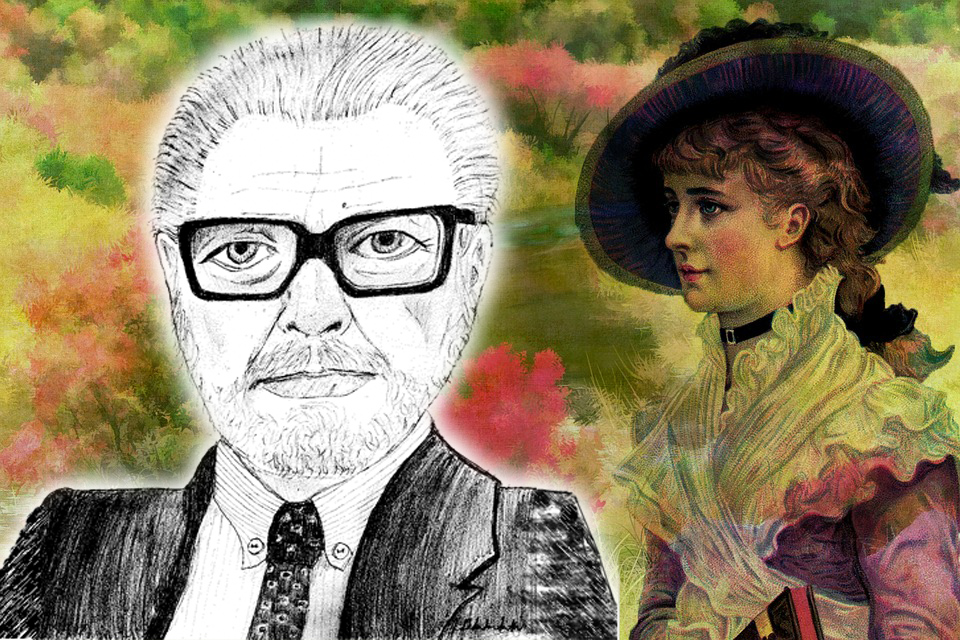
Wayne C. Booth—Jane Austen, Emma, and Ironic Distance
Priscilla Collins
In his essay “Control of Distance in Jane Austen’s Emma” (which is taken from his more seminal work, The Rhetoric of Fiction), critic and University of Chicago professor Wayne C. Booth shows how thoughtful Jane Austen was in her narration of two female protagonists—Emma Woodhouse and Anne Elliot from Austen’s later novel Persuasion—and their stories of love. Author and critic Henry James once said that Austen causes her readers to react as “she consciously intends.” Booth further contends that such an effect is accomplished because Austen is an “unquestionable master of the rhetoric of narration” (Booth 35).
Booth argues that Jane Austen “controls the distance” in Emma and Persuasion in two ways: by highlighting Emma as imperfect, but good and Anne as imperfect, but stubborn. Both women are controlled by the narrator in a way that adds to both of these characters. For example, consider how Emma begins—a charming young woman who seems to have it all (intelligence, beauty, charm, and wit) and yet is lead to unhappiness by her own doings. Thus, the story of Emma resolves itself when she realizes her mistakes and prideful ways, and then she precedes to reform herself and repair the damage she’s caused in preparation for her own worthy and fulfilling marriage.
Austen had set the stage for a difficult story to unfold. The rhetorical problem, according to Booth, that must be solved with well-written rhetoric is this:
If we fail to see Emma’s faults as revealed in the ironic texture from line to line, we cannot savor to the full the comedy as it is prepared for us. On the other hand, if we fail to love her, as Jane Austen herself predicted we would― if we fail to love her more and more as the book progresses― we can neither hope for the conclusion, a happy and deserved marriage with Knightley following upon her reform, nor accept it as an honest one when it comes. (Booth 36)
According to Booth, Austen must solve this conflict without losing the honesty of revealing the faults of Emma while also showing the love that she has for Knightley, which Austen accomplished through the narration of Emma. Booth tells how Austen keeps the story in the third person, but tells the story mostly through Emma’s point of view. By providing this to the readers, Austen forces us to see the redemption of Emma from the outside in.
Austen’s narration is so rhetorically convincing, that Booth argues we as readers not only see the conviction and honesty in Emma’s change, but we desire to see it despite Emma’s past meddlesome acts and prideful mistakes.
By showing most of the story through Emma’s eyes, the author insures that we shall travel with Emma rather than stand against her. It is not simply that Emma provides, in the unimpeachable evidence of her own conscience, proof that she has many redeeming qualities that do not appear on the surface; such evidence could be given with authorial commentary, though perhaps not with such force and conviction. Much more important, the sustained inside view leads the reader to hope for good fortune for the character with whom he travels, quite independently of the qualities revealed. (Booth 37)
The careful narration and rhetoric created by Austen causes the readers to keep just enough sympathy for Emma that they continue to cheer for her until the very end. However, in the story of Persuasion, the control of distance is handled altogether differently. The narration comes mostly from Anne, but much of it comes from the thoughts of different characters.
Her ‘omniscience’ is thus a much more remarkable thing than is ordinarily implied by the term. All good novelists know all about their characters― all that they need to know. And the question of how their narrators are to find out all that they need to know, the question of ‘authority,’ is a relatively simple one. The real choice is much more profound than this would imply. It is a choice of the moral, not merely the technical, angle of vision from which the story is to be told. (52)
The various views strengthened the virtues in which Anne does not even see in herself― ones of humility, love, and patience. Like Emma, Anne eventually sees what has been in front of her all along: a man that loves her despite her flaws. As Professor Booth puts it so aptly, when it comes to both Anne and Emma, “it is precisely because this ending is neither life itself nor a simple bit of literary irony that it can serve so well to heighten our sense of a complete and indeed perfect resolution to all that has gone before” (47).
Indeed, Booth strongly illustrates here an argument that he continues to sharpen and refine throughout The Rhetoric of Fiction: that all novels, especially the ones we love the most, are rhetorical. Indeed, the power of Jane Austen as a novelist lies in her greatness as a master of narrative rhetoric. This is perhaps another way of saying what most of us know to be true: much of the power of the story lies in the telling, which is where rhetoric comes in.
(1). Booth, Wayne C. “Control of Distance in Jane Austen’s Emma.“ The Essential Wayne Booth. Edited by Walter Jost. University Press of Chicago, 2006. Print.